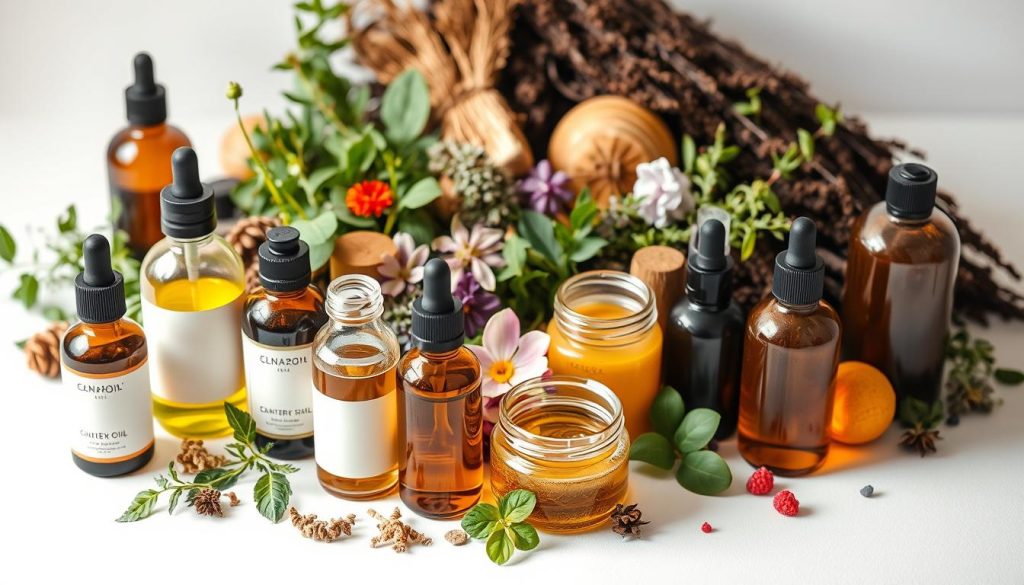Do you worry if your hair products might be bad rather than good? With so many natural hair care choices, it’s key to know what’s in them. The right stuff in these products can make our hair look stunning. But the wrong ones can mess it up. Let’s find out what makes hair care products good or bad. And learn what to stay away from on labels.
Key Takeaways
- Understanding ingredients is vital for our hair health.
- Natural hair care choices can enhance our hair’s beauty.
- Reading labels helps us avoid harmful substances.
- Choosing sustainable beauty products supports the environment.
- Not all ingredients are created equal—know the key players!
Understanding the Importance of Hair Product Ingredients
Exploring hair care means knowing what’s in our products. The ingredients are key for healthy, shiny hair. Picking the right stuff helps nourish our hair and avoid damage. Organic treatments tap into nature’s goodness, keeping our locks safe from harsh stuff. Clean beauty means using products that are kinder to the planet and us. Knowing what each ingredient does helps us choose wisely.
Why Ingredients Matter for Our Hair Health
What’s in our hair products hugely affects their health. These ingredients influence moisture levels and hair strength. Organic options are gentler and less likely to irritate our scalp or hair. Clean beauty avoids bad additives, preventing damage down the track.
The Difference Between Natural and Synthetic Ingredients
It’s important to know the difference between natural and synthetic ingredients. Naturals come from plants and minerals, and are usually softer on our hair. Synthetics might work fast but can harm in the long run. Organic treatments safeguard our hair’s natural beauty.
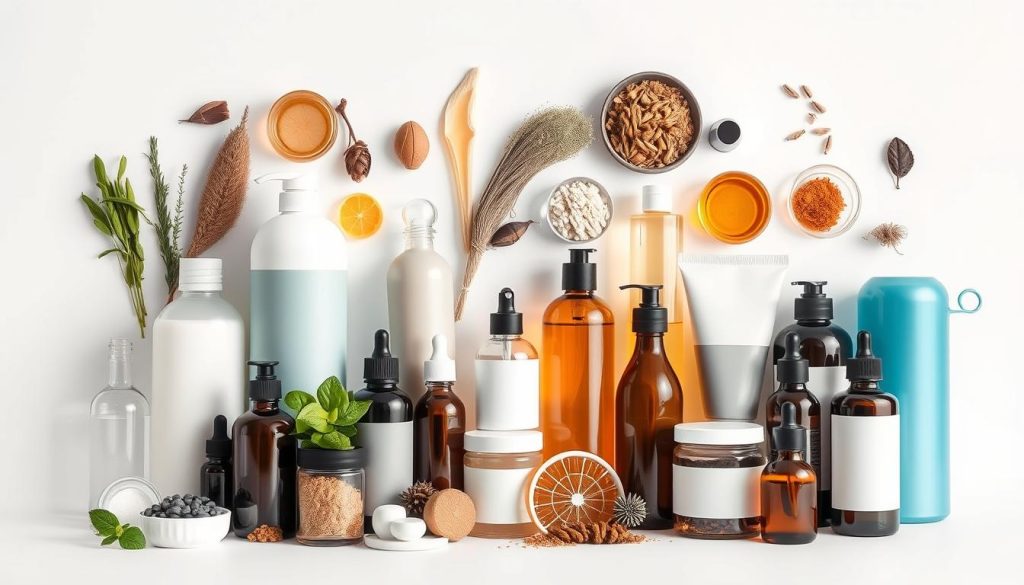
Essential Oils: Nature’s Best for Our Tresses
Essential oils are awesome for improving hair health. Using argan and jojoba oil can really change how we look after our hair. Our hair looks shinier and feels stronger because of them. These natural remedies help our hair look great and feel balanced.
Argan Oil for Moisture and Shine
Argan oil is a top choice for natural hair care. It has essential fatty acids and antioxidants. These ingredients hydrate and nourish our hair. Applying argan oil makes our hair shiny and soft. It’s like giving our hair a healthy meal.
Jojoba Oil for Balanced Scalp
Jojoba oil is great for keeping our scalp healthy. It’s similar to the oils our body makes. So, it moisturizes without being greasy. It helps get rid of dryness and keeps our scalp happy. Using jojoba oil shows we care about using plant-based products for our hair.
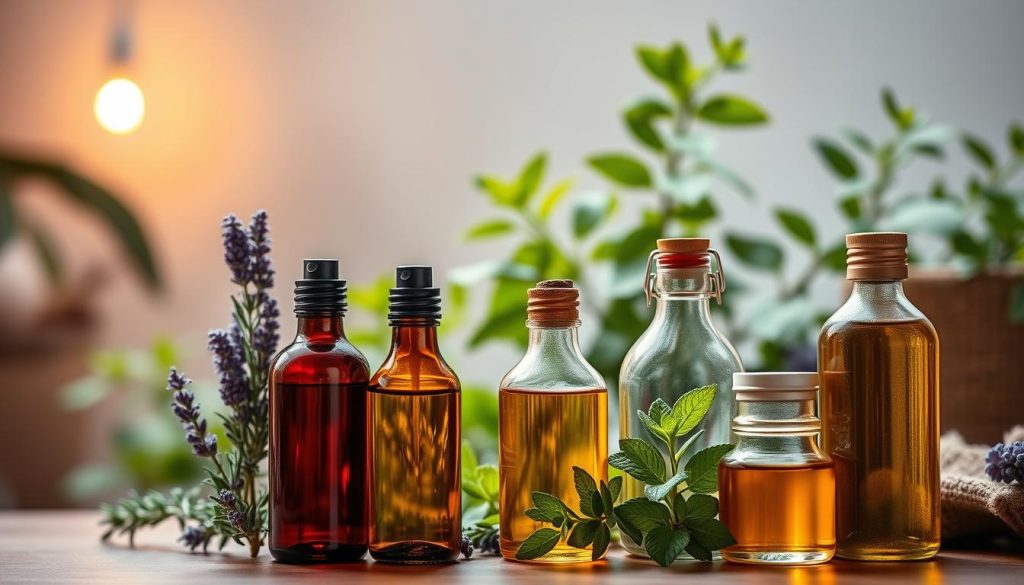
Proteins That Strengthen Our Strands
Proteins are key for keeping our hair strong and healthy. We often choose hair products with certain ingredients for this reason. These ingredients, like keratin and silk protein, help our hair stay tough and look good.
Keratin: The Building Block of Our Hair
Keratin is a vital protein in our hair. It makes our hair strong and defends it from damage. Using keratin-based products can make our hair healthier and shinier.
This can lessen hair breakage and improve the health of our hair.
Silk Protein for Smoothness
Silk protein helps our hair become smooth and shiny. It’s great for taming frizz and giving our hair a soft touch. By choosing products with silk protein, our hair becomes easier to manage and looks brighter.
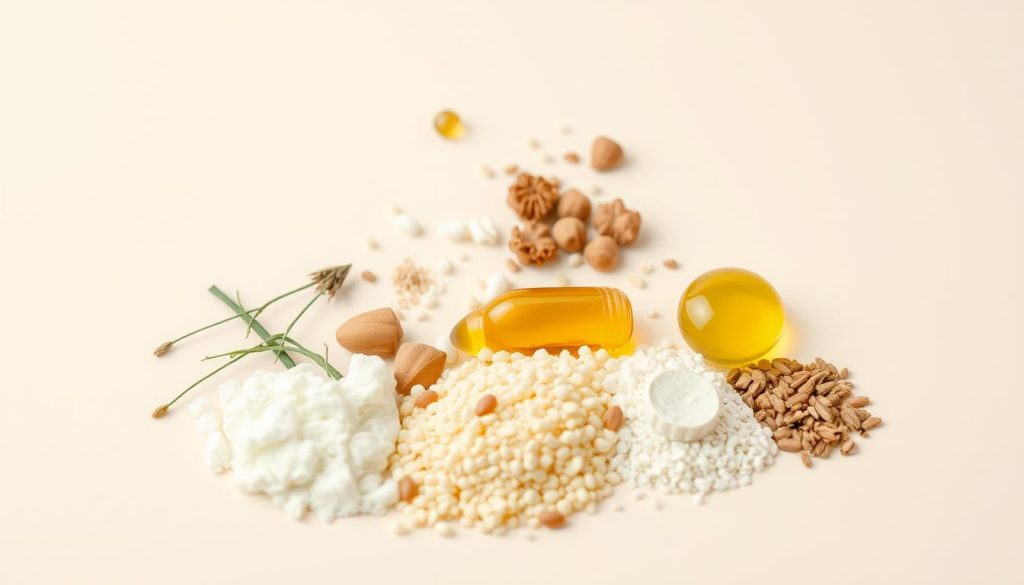
Hydrating Ingredients We Should Look For
Hydration is key to healthy hair. We need to pick products with ingredients known for holding in moisture. Aloe vera and glycerin are top picks. They’re found in chemical-free and eco-friendly hair products.
Aloe Vera: Soothing and Moisturising
Aloe vera is a champion for our hair. It soothes dryness and irritation on our scalps. At the same time, it hydrates our hair. Adding aloe vera to our routine makes hair softer and keeps our scalp healthy. This keeps our hair looking fresh and nourished.
Glycerin: A Natural Humectant
Glycerin draws moisture from the air right into our hair. This stops our hair from becoming dry and brittle. As a result, our hair feels healthier and easier to manage. So, glycerin is a must-have in products for better hydration.
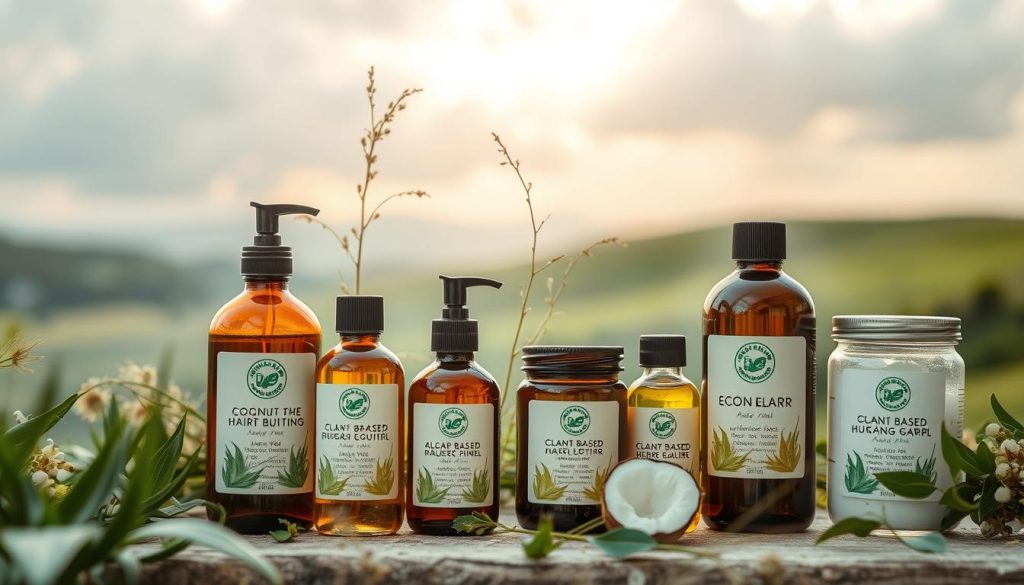
Opting for products with aloe vera and glycerin helps us get healthier hair. It also supports the demand for greener beauty options. These ingredients show that we can make choices that are good for us and the planet.
Nourishing Our Hair with Vitamins
Vitamins are key for keeping our hair healthy, and they make a big difference to how it looks and feels. By using the right hair product ingredients, we can make our hair vibrant and strong. Vitamin E and Biotin are two important vitamins for great hair.
Vitamin E: Antioxidant Powerhouse
Vitamin E protects our hair from damage with its antioxidant powers. It supports hair growth and improves blood flow to the scalp. By using products with Vitamin E, we feed our hair from within.
Biotin: The Hair Growth Vitamin
Biotin is famous for helping hair grow and stopping it from falling out. This vitamin makes hair strands stronger and thicker. Including biotin in our hair care means our hair stays healthy and tough.
| Vitamin | Benefits | Common Sources |
|---|---|---|
| Vitamin E | Antioxidant protection, improved scalp circulation | Almonds, avocados, spinach |
| Biotin | Promotes hair growth, strengthens strands | Eggs, nuts, whole grains |
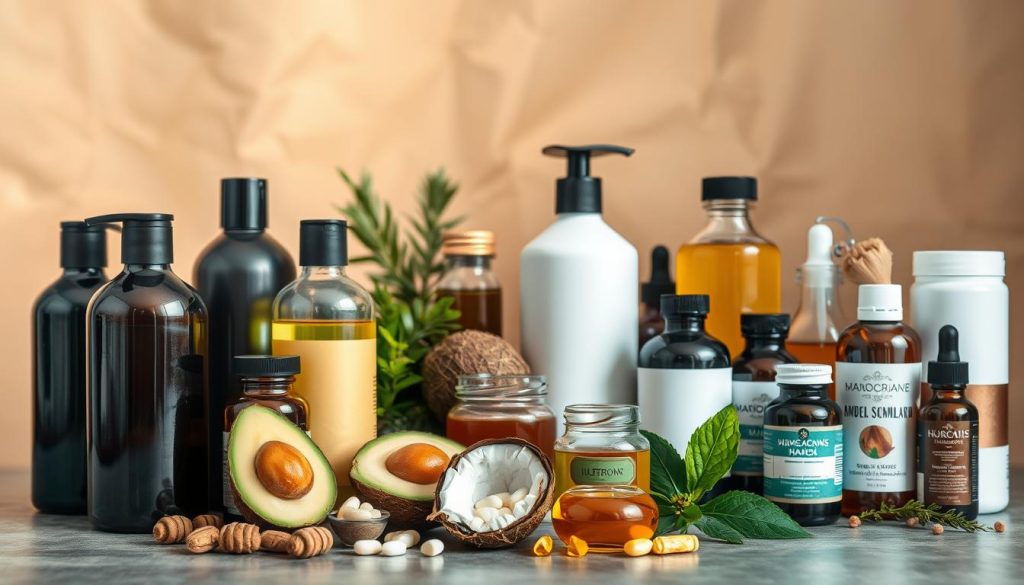
The Role of Surfactants in Hair Care
Surfactants are key in keeping our hair clean, helping remove dirt and oil. Learning about their role, especially sulfates, lets us choose better hair care products.
Sulfates: The Good and the Bad
Sulfates are in many shampoos for their cleaning power. They help our hair feel fresh by creating a rich lather. However, they might remove too much natural oil, causing dryness and scalp irritation. This is a bigger issue for people with sensitive skin or dry hair. Finding the right balance is important.
Gentle Alternatives to Consider
If you prefer natural hair care, there are mild options available. Ingredients like sulfosuccinates and betaines clean softly, avoiding the roughness sulfates can cause. These choices help keep the scalp’s moisture while still cleaning well. This way, we can have healthier hair and scalp by making mindful choices.
| Surfactant Type | Cleansing Power | Gentleness | Common Examples |
|---|---|---|---|
| Sulfates | High | Low | Sodium Lauryl Sulfate (SLS), Sodium Laureth Sulfate (SLES) |
| Sulfosuccinates | Medium | High | Sodium Cocoyl Isethionate |
| Betaines | Medium | High | Cocamidopropyl Betaine |
Choosing the right surfactants in our hair care ensures a good clean without losing moisture. This balance helps keep our hair healthy and hydrated.
Preservatives: Keeping Our Products Safe
We often forget how important preservatives are in our hair care. They stop microbes from growing and keep products safe. With more eco-friendly beauty items popping up, knowing about natural and man-made preservatives is key. This helps us pick the safest options for our hair routine.
Natural Preservatives We Can Trust
Using natural preservatives fits with picking cleaner beauty products. Things like rosemary extract and vitamin E are good for both preserving and benefiting our hair. By choosing these, we avoid the harsh chemicals in many artificial preservatives.
Why Preservatives Are Necessary
Preservatives are vital to make hair products last longer and stay free from bad bacteria and mold. Without them, our favorite items could go bad fast. This would not only be disappointing but could also be risky. Picking products with safe preservatives makes sure our hair care is both effective and safe.
Fragrance in Hair Products: What to Know
Fragrance is key in our hair care routines. It makes our experience more enjoyable and can impact our hair’s health. Knowing the difference between natural and synthetic scents is important. It helps to identify potential allergens too.
Natural Fragrance vs. Synthetic
Natural fragrances come from essential oils and smell great without harsh chemicals. Many choose organic hair treatments for this reason. These products are free from harmful additives, making them a safer option for our hair.
Potential Allergens in Fragrances
Even with natural scents, we need to be careful. Both types of fragrances might have allergens. Patch tests and checking ingredients carefully can show us which products are best for us. This way, we can enjoy nice smells without harming our hair.
Understanding pH Balance for Our Hair
Keeping our hair and scalp’s pH balance right is key to healthy hair. The perfect pH level helps our hair grow well. It also stops problems like damage and dryness. By using products with the right ingredients, we can keep our hair happy.
How pH Affects Our Hair Health
Our hair and scalp do best at a slightly acidic pH, from 4.5 to 5.5. At this spot, our hair’s outer layer stays smooth, keeping it safe. But, if the pH goes up, the outer layer opens. This makes hair frizzy and more likely to get damaged. Using natural, plant-based hair care helps keep the pH just right.
Products to Maintain Optimal pH
It’s crucial to pick products made to keep the pH balance. Here’s a list of different hair products and their pH levels:
| Product Type | Typical pH Range | Benefits |
|---|---|---|
| Shampoos | 4.5 – 5.5 | Gently cleanses while respecting hair’s natural oils. |
| Conditioners | 4.0 – 5.0 | Seals cuticles to lock in moisture and shine. |
| Hair Masks | 5.0 – 6.5 | Deeply nourishes and restores dry or damaged hair. |
| Leave-in Treatments | 4.5 – 6.0 | Offers long-lasting protection and hydration. |
Choosing the right products for our hair’s pH can keep it healthy and shining. By focusing on the best ingredients, our hair can stay strong and lively.
How to Read Hair Product Labels Effectively
Learning how to read hair product labels helps us pick wisely for our hair care. It lets us choose products that are good for our hair health and eco-friendly. We can spot helpful ingredients and steer clear of bad chemicals.
Decoding Ingredients Lists
Start with the top ingredients on the list. The first ingredients are in the highest amount. Paying attention to key beneficial elements helps us judge the product better. Look for natural oils, proteins, and hydrators for healthy hair.
Spotting Red Flag Ingredients
We need to watch out for harmful ingredients, such as:
- Sulfates, which take away our hair’s natural oils.
- Parabens, used to keep products fresh but might be harmful.
- Formaldehyde and similar harsh chemicals.
Understanding labels can really change our hair care game. It leads us to safer, effective eco-friendly beauty products.
The Impact of Hair Product Ingredients on the Environment
Choosing the right hair care products is important, especially for the environment. We make a big difference by choosing eco-friendly shampoo and conditions. These products use natural stuff and help reduce our mark on the planet. By picking sustainable beauty items, we’re doing our bit for Earth and keeping our hair healthy.
Eco-Friendly Ingredients to Opt For
It’s a good idea to look out for hair products with green ingredients. Doing this is better for the Earth and your hair. Key ingredients include:
- Coconut Oil: Great for making your hair soft, without any nasty chemicals.
- Aloe Vera: It hydrates your hair and is kind to the environment.
- Shea Butter: Feeds your hair, without hurting the planet.
Cruelty-Free Brands We Can Support
Choosing brands that don’t test on animals is another way to do our bit. This choice supports kind values and encourages a kinder industry. Some good choices are:
- Oway: They’re all about being green and using eco-friendly packages.
- Aveda: They make natural hair care goods without testing on animals.
- 100% Pure: They focus on ingredients that are safe for the planet and animals.
Tips for Choosing the Right Hair Products
Choosing the right hair products is key for healthy, shiny hair. Identifying ingredients that suit our hair type is crucial. This approach makes sure our hair gets what it needs. Whether we have straight, curly, oily, or dry hair, using the right ingredients improves our hair care routine.
Matching Ingredients with Our Hair Type
We should pick products with natural ingredients that fit our hair’s needs. For example, aloe vera or shea butter are great for dry, frizzy hair. They add moisture. For oily hair, light botanical products control oiliness well, without removing natural oils.
Sample Testing: Finding Our Perfect Match
Trying out different product samples is smart. Many brands offer small sizes or sample kits for us to test. This way, we can see how they work on our hair and scalp. It leads us to find the right products, resulting in healthy, beautiful hair.

